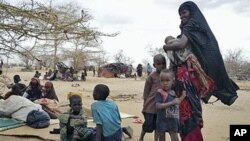The top U.S. official for refugee issues says that despite intensive efforts, relief agencies have made little progress in reducing child mortality rates at refugee camps along Somalia's border with Ethiopia. Deputy Assistant Secretary of State Reuben Brigety made the comment as he returned from Dollo Ado, a sprawling camp complex in Ethiopia that houses 120,000 refugees from famine-stricken southern Somalia.
Brigety, the U.S. government’s point man for refugee and migration affairs, has just returned from his third overnight visit to Dollo Ado this year.
He tells VOA that humanitarian agencies have made impressive progress in establishing health facilities and registering the backlog of refugees arriving daily from Somalia’s famine zone. But he said children are still dying at an alarming rate of malnutrition and other complications, such as measles.
"The level of mortality is still as high as it was two months ago. There was a measles outbreak recently, which fortunately actors responded to with a great deal of alacrity. But we’re seeing rates of malnutrition among the young children coming in that are as high as they were six weeks ago, so we have to work harder to figure out how we can bring those things down," he said.
Unacceptable mortality rate
Brigety said at the worst of the four Dollo Ado camps, the mortality rate among children under five is more than 15 per 10,000 per day.
The overall famine death toll among Somalis is believed to be well over 30,000 and rising daily. But the heart of the famine zone in southern Somalia is closed to humanitarian workers. It is controlled by the Islamic radical group al-Shabab, making it is impossible to know how many more are dying.
Brigety said those staying in Somalia likely are in worse condition than those who have made it to the camps.
"Those that remain behind, large numbers of them presumably would like to leave but simply don’t have the physical strength or can’t muster the resources to be able to move," he said. "We know there is very little to no food in the al-Shabab-held areas of south-central Somalia, which is why these areas have been declared in famine, and why we anticipate all of south-central Somalia to be in famine by October."
Breaking al-Shabab's grip
Brigety said newly-arrived refugees he has spoken to usually have little or no knowledge of al-Shabab or Somalia’s political failures that led to the famine. They are just in desperate need of help.
"One young mother, who couldn’t have been more than 20, nursing her little child, said she doesn’t know what the future holds for her, she’s just here and God will determine what happens to her. They have no affinity for al-Shabab whatsoever. These are people that are not political, they don’t have a particular ideology or agenda. They just want to survive," said Brigety.
The U.S. official said sleeping in a tent in the dust-blown Dollo Ado camp gives him a sense of the challenges facing the humanitarian workers trying to save countless children suffering severe malnutrition, measles and more.
"Just from my stay overnight, when I came back to have a shower, I was wiping dust out of my ears for a while and that’s just when I was there overnight. For the people who have to live in that environment, living through constant dust storms and constant heat, they are alive, but beyond that it’s an incredibly challenging existence," he said.
Brigety said his main worry is that famine will kill tens of thousands more people in short order unless the international community is able to intervene in Shabab-controlled areas inside Somalia in what he called “unfettered and robust fashion."



















